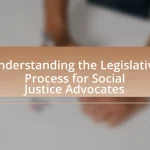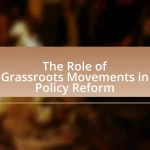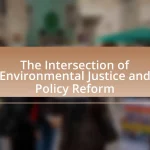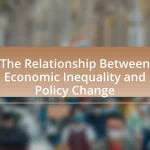The article examines the significant influence of policy change on local communities, highlighting its effects on economic conditions, social dynamics, and access to resources. It discusses how changes in policies, such as minimum wage increases and housing regulations, can directly impact employment rates, community cohesion, and overall well-being. Additionally, the article explores the role of local governments in implementing these changes, the importance of community engagement, and the long-term implications for community development. Key aspects such as health outcomes, resource distribution, and social equity are also analyzed, providing a comprehensive overview of how policy shifts shape the fabric of local communities.

What is the Influence of Policy Change on Local Communities?
Policy change significantly influences local communities by altering economic conditions, social dynamics, and access to resources. For instance, the implementation of a minimum wage increase can lead to higher income levels for workers, which in turn stimulates local economies through increased consumer spending. A study by the National Bureau of Economic Research found that cities that raised their minimum wage experienced a 3% increase in employment in the retail sector, demonstrating a direct correlation between policy changes and local economic growth. Additionally, policy changes regarding housing regulations can affect community demographics and housing affordability, impacting social cohesion and community stability. Thus, the influence of policy change on local communities is profound, affecting various aspects of daily life and overall community well-being.
How do policy changes impact the social fabric of local communities?
Policy changes significantly impact the social fabric of local communities by altering the dynamics of social interactions, resource distribution, and community engagement. For instance, the introduction of affordable housing policies can enhance community cohesion by providing stable living conditions, which fosters stronger neighborhood ties. Conversely, policies that lead to gentrification can displace long-term residents, disrupting established social networks and increasing social tensions. Research from the Urban Institute indicates that policy shifts in housing and zoning can lead to changes in demographic composition, affecting community identity and social cohesion. Thus, the nature of policy changes directly influences how communities interact, support one another, and maintain their cultural integrity.
What are the key social aspects affected by policy changes?
Key social aspects affected by policy changes include community cohesion, access to resources, and social equity. Community cohesion can be disrupted or strengthened depending on how policies are implemented, influencing social networks and relationships among residents. Access to resources, such as healthcare, education, and employment opportunities, is often altered by policy changes, impacting the overall well-being of individuals and families. Social equity is also a critical aspect, as policies can either promote inclusivity or exacerbate inequalities among different demographic groups. For instance, research by the Urban Institute highlights that policy changes in housing can lead to increased displacement of low-income families, affecting their social stability and access to essential services.
How do community dynamics shift in response to policy changes?
Community dynamics shift significantly in response to policy changes, as these alterations can influence social interactions, resource allocation, and collective behavior. For instance, when a local government implements a new housing policy, it may lead to increased housing availability, which can foster greater community engagement and collaboration among residents. Conversely, policies that restrict access to resources, such as funding cuts to social services, can result in increased tension and fragmentation within the community. Research by the Urban Institute indicates that policy changes can lead to shifts in community cohesion, with communities often adapting their social structures and networks in response to new regulations or support systems.
What economic effects do policy changes have on local communities?
Policy changes can significantly impact local communities by altering economic conditions, employment rates, and access to resources. For instance, a change in tax policy may lead to increased funding for local services, which can enhance public infrastructure and create jobs. Conversely, cuts in social welfare programs can result in higher poverty rates and reduced consumer spending, negatively affecting local businesses. Research from the Urban Institute indicates that policy shifts, such as minimum wage increases, can lead to higher earnings for low-income workers, thereby stimulating local economies. These economic effects demonstrate the direct correlation between policy changes and the financial well-being of communities.
How do policy changes influence local employment rates?
Policy changes significantly influence local employment rates by altering economic conditions, regulatory environments, and workforce dynamics. For instance, when a government implements tax incentives for businesses, it can lead to increased hiring, as companies have more capital to invest in labor. A study by the National Bureau of Economic Research found that local employment rates rose by 3% in areas where tax incentives were introduced, demonstrating a direct correlation between policy changes and job creation. Additionally, changes in labor laws, such as minimum wage increases, can impact employment levels by affecting business costs and hiring practices. Therefore, the nature and scope of policy changes play a crucial role in shaping local employment landscapes.
What is the impact of policy changes on local businesses?
Policy changes significantly affect local businesses by altering operational costs, regulatory compliance, and market dynamics. For instance, a rise in minimum wage laws can increase labor costs for small businesses, potentially leading to reduced hiring or increased prices for consumers. Conversely, tax incentives for local enterprises can stimulate growth and investment, enhancing competitiveness. Research from the National Bureau of Economic Research indicates that policy shifts can lead to a 10-20% variation in local business revenues, demonstrating the tangible impact of legislative changes on economic performance.
How do policy changes affect community health and well-being?
Policy changes significantly impact community health and well-being by altering access to healthcare services, influencing health behaviors, and shaping the social determinants of health. For instance, the implementation of the Affordable Care Act in the United States expanded health insurance coverage to millions, resulting in increased access to preventive services and a reduction in uninsured rates, which improved overall health outcomes. Additionally, policies that promote healthy environments, such as smoke-free laws and regulations on food marketing, have been shown to decrease smoking rates and improve dietary habits, thereby enhancing community health. Research indicates that communities with supportive health policies experience lower rates of chronic diseases and improved mental health, demonstrating the direct correlation between policy changes and community well-being.
What health services are impacted by policy changes?
Policy changes significantly impact various health services, including preventive care, mental health services, and access to medications. For instance, changes in insurance policies can lead to reduced coverage for preventive screenings, which directly affects early disease detection and management. Additionally, shifts in funding for mental health programs can limit access to essential services, resulting in increased barriers for individuals seeking help. Furthermore, alterations in pharmaceutical regulations can affect the availability and affordability of medications, influencing patient adherence to treatment plans. These examples illustrate how policy changes can disrupt the delivery and accessibility of critical health services within communities.
How do policy changes influence public health outcomes?
Policy changes significantly influence public health outcomes by altering access to healthcare services, modifying health behaviors, and impacting social determinants of health. For instance, the implementation of smoke-free laws has been shown to reduce smoking rates and improve respiratory health in populations, as evidenced by a study published in the American Journal of Public Health, which found a 20% decrease in hospital admissions for asthma after such laws were enacted. Additionally, policies that expand Medicaid coverage have been linked to increased access to preventive care and a reduction in mortality rates, as reported in research by the National Bureau of Economic Research, which highlighted a 6.1% decline in mortality among low-income adults following Medicaid expansion. These examples illustrate how targeted policy changes can lead to measurable improvements in public health outcomes.
What role do local governments play in implementing policy changes?
Local governments play a crucial role in implementing policy changes by translating broader legislative mandates into actionable local initiatives. They are responsible for enacting ordinances, allocating resources, and managing public services that align with new policies. For instance, when a state-level environmental policy is introduced, local governments must develop specific regulations and programs to ensure compliance, such as waste management systems or zoning laws that promote sustainability. This localized approach allows for tailored solutions that address the unique needs of the community, thereby enhancing the effectiveness of policy implementation.
How do local governments communicate policy changes to communities?
Local governments communicate policy changes to communities primarily through public announcements, community meetings, and digital platforms. These methods ensure that residents are informed about new policies and their implications. For instance, local governments often utilize social media, official websites, and newsletters to disseminate information quickly and effectively. According to a study by the International City/County Management Association, 75% of local governments reported using social media as a key tool for communication, highlighting its importance in reaching diverse community members. Additionally, public forums and town hall meetings allow for direct engagement, enabling residents to ask questions and provide feedback, which fosters transparency and trust in the policy-making process.
What strategies do local governments use to mitigate negative impacts of policy changes?
Local governments employ various strategies to mitigate negative impacts of policy changes, including stakeholder engagement, adaptive policy frameworks, and targeted financial assistance. Stakeholder engagement involves actively involving community members and local organizations in the decision-making process, which helps to identify potential issues and gather diverse perspectives. Adaptive policy frameworks allow local governments to adjust policies based on real-time feedback and changing circumstances, ensuring that policies remain effective and relevant. Targeted financial assistance, such as grants or subsidies, can support affected individuals or businesses, helping them to adjust to new policies without severe economic hardship. These strategies are supported by evidence showing that inclusive decision-making and flexible policy approaches lead to better outcomes in community resilience and satisfaction.
How can communities adapt to policy changes effectively?
Communities can adapt to policy changes effectively by engaging in proactive communication and collaboration among stakeholders. This involves organizing forums and workshops to discuss the implications of policy changes, allowing community members to voice concerns and share insights. Research indicates that communities that foster inclusive dialogue and collective problem-solving are better equipped to navigate policy shifts, as evidenced by case studies in urban planning where stakeholder engagement led to more resilient community responses. Additionally, establishing partnerships with local organizations and government entities can facilitate resource sharing and support, enhancing the community’s ability to implement necessary adjustments in response to new policies.
What are best practices for community engagement during policy changes?
Best practices for community engagement during policy changes include actively involving community members in the decision-making process, ensuring transparency, and providing accessible information. Engaging community members through surveys, public meetings, and focus groups allows for diverse perspectives to be heard, which can lead to more effective policies. Transparency in sharing information about the policy changes fosters trust and encourages participation. Additionally, using clear and straightforward language in communications ensures that all community members, regardless of their background, can understand the implications of the changes. Research indicates that communities that are actively engaged in policy discussions are more likely to support and adhere to new policies, as seen in studies conducted by the International Association for Public Participation, which highlight the positive correlation between engagement and policy acceptance.
How can communities advocate for favorable policy changes?
Communities can advocate for favorable policy changes by organizing collective actions, engaging in dialogue with policymakers, and utilizing data to support their positions. Collective actions, such as protests or community meetings, create visibility and demonstrate public support for specific issues. Engaging in dialogue with policymakers allows communities to present their needs and concerns directly, fostering relationships that can lead to policy changes. Utilizing data, such as statistics on local issues or case studies from similar communities, strengthens arguments and provides evidence that can persuade decision-makers. For instance, a study by the National Civic League found that communities that actively engage in advocacy efforts are more likely to see successful policy outcomes, highlighting the effectiveness of organized community efforts in influencing local governance.
What are the long-term implications of policy changes on local communities?
Long-term implications of policy changes on local communities include shifts in economic stability, social cohesion, and access to resources. For instance, changes in zoning laws can lead to increased property values, which may displace lower-income residents, thereby altering the community’s demographic makeup and social fabric. Additionally, policies that affect public services, such as education and healthcare, can result in disparities in access and quality, impacting community health and educational outcomes over time. Research indicates that communities experiencing significant policy shifts often face challenges in maintaining social networks and economic opportunities, as evidenced by studies showing that areas with reduced funding for public services see increased rates of poverty and crime.
How do policy changes shape future community development?
Policy changes significantly shape future community development by altering funding allocations, regulatory frameworks, and resource distribution. For instance, when a government implements policies that prioritize affordable housing, it can lead to increased investment in housing projects, thereby improving living conditions and community stability. Research from the Urban Institute indicates that policy shifts towards inclusive zoning can enhance access to housing for low-income families, fostering economic diversity within neighborhoods. Additionally, changes in environmental policies can promote sustainable development practices, influencing how communities plan for growth and resource management. These examples illustrate that policy changes directly impact the trajectory of community development by determining the availability of resources and the priorities of local governance.
What lessons can be learned from past policy changes in local communities?
Lessons learned from past policy changes in local communities include the importance of community engagement, the need for data-driven decision-making, and the recognition of unintended consequences. Community engagement fosters trust and ensures that policies reflect the needs and values of residents, as seen in participatory budgeting initiatives that have led to increased civic participation and satisfaction. Data-driven decision-making, exemplified by the use of impact assessments in urban planning, helps identify effective strategies and allocate resources efficiently. Additionally, recognizing unintended consequences, such as gentrification resulting from housing policies, highlights the necessity of comprehensive evaluations to mitigate negative impacts. These lessons underscore the critical role of inclusive processes and evidence-based approaches in shaping effective local policies.
What practical steps can communities take to navigate policy changes?
Communities can navigate policy changes by actively engaging in advocacy, forming coalitions, and participating in public consultations. Advocacy allows communities to voice their concerns and influence decision-makers, while coalitions can amplify their efforts by uniting various stakeholders with shared interests. Public consultations provide a platform for communities to express their needs and preferences, ensuring that their perspectives are considered in the policymaking process. Research indicates that communities that engage in these practices are more likely to achieve favorable outcomes in policy changes, as seen in the case of community-led initiatives that successfully influenced local zoning laws in various cities.










